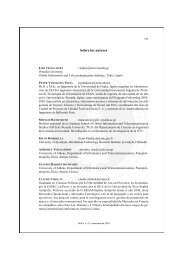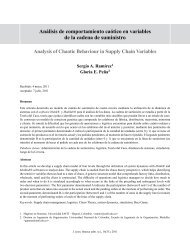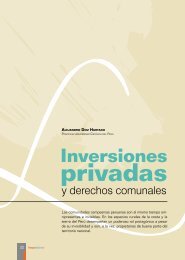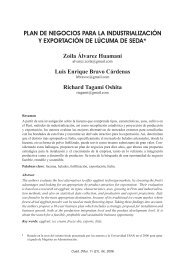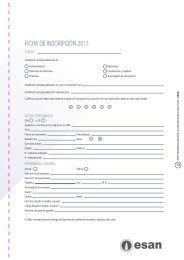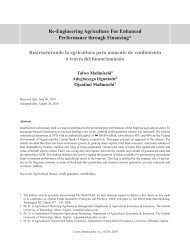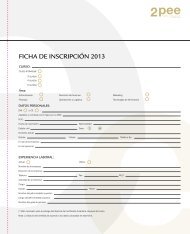Hofstede's Cultural Dimensions and Tourist Behaviors: A ... - Esan
Hofstede's Cultural Dimensions and Tourist Behaviors: A ... - Esan
Hofstede's Cultural Dimensions and Tourist Behaviors: A ... - Esan
Create successful ePaper yourself
Turn your PDF publications into a flip-book with our unique Google optimized e-Paper software.
38 Journal of Economics, Finance <strong>and</strong> Administrative ScienceDecember 2011A factor analysis of the data on these 13 Chinese<strong>Cultural</strong> values yielded four factors. The first factorwas labeled “Social Integration” <strong>and</strong> included five variables:adaptability, contentedness, courtesy, prudence,<strong>and</strong> trustworthiness (adaptability variable was laterdeleted due to its factor loading of less than 0.50). Thesecond factor was labeled by the authors “ConfucianWork Dynamism” (referred to as “Work Dynamism”in the present research paper) <strong>and</strong> included three items:patience, respect for tradition <strong>and</strong> thrift (the thrift variablewas later deleted because the internal reliabilitytest indicated that deleting this variable will increasethe alpha coefficient from 0.58 to 0.62). The third factorwas labeled “Personal Well-Being” <strong>and</strong> included threeitems: being conservative, protecting face, <strong>and</strong> reciprocity.The fourth factor was labeled “Moral Discipline”<strong>and</strong> included two variables: harmony with others <strong>and</strong>tolerance of other.In order to jointly examine the relationship of HongKong Chinese tourists’ behavior on group tour packageswith Chinese <strong>Cultural</strong> Values, canonical correlationanalysis was performed. The results yielded four functionsof which two were significant at p1.3% for both travelrelated behavior <strong>and</strong> Chinese <strong>Cultural</strong> Values, onlyone of the two functions was used for further analysis.The canonical loadings <strong>and</strong> canonical cross-loadings ofthis function for each of the 22 travel related variables<strong>and</strong> each of the four Chinese <strong>Cultural</strong> Value factorswere computed. The variables with canonical loadings>0.40 within the same set (travel related behaviors setor Chinese <strong>Cultural</strong> Values factors set) <strong>and</strong> canonicalcross-loadings >0.30 between two sets (travel behaviorsset <strong>and</strong> Chinese <strong>Cultural</strong> Values factors set) wereidentified.The results of canonical loadings for 22 travel relatedbehaviors indicated that three correlated variableswithin the set of travel behaviors were travel in groupsversus travel by themselves, adventurous versus safe<strong>and</strong> joining all self-paid activities suggested by tourversus not joining. Hong Kong Chinese tourists takinggroup tours preferred safe activities <strong>and</strong> they alsopreferred to take all self-paid activities as suggested bytour. The canonical loadings for the four cultural valuefactors indicated that two out of the four factors met thecriterion, Social Integration factor <strong>and</strong> Personal Well-Being factor, implying that these two factors had greaterrelevance for the cultural values concept compared toother two factors, Work Dynamism factor <strong>and</strong> MoralDiscipline factor.As regards the results of canonical cross-loadings,only two travel behaviors, travel in groups/travel bythemselves <strong>and</strong> adventurous versus safe, correlated withSocial Integration <strong>and</strong> Personal Well-Being. Takinginto consideration the relative importance of the ratingsof different cultural values, the authors conclude thatSocial Integration values, such as courtesy, prudence,<strong>and</strong> trustworthiness, exert an important influence on thebehavior of tourists on group package tours, whereasPersonal Well-Being values such as being conservative<strong>and</strong> protecting face are not as important.The authors further discuss why the four Chinese<strong>Cultural</strong> Value factors were found relevant or irrelevantin their study. The social integration factor explainedthe largest proportion (25.1%) of the variance <strong>and</strong>the values included in this factor (courtesy, prudence,trustworthiness, <strong>and</strong> contentedness) were consideredrelevant for social interaction in a collectivistic settinglike taking a group package tour. The second factor,Work Dynamism, included values such as respect fortradition <strong>and</strong> patience, <strong>and</strong> it explained 13.4% of thevariance. The authors suggest that while Work Dynamismvalues are more unconscious <strong>and</strong> sophisticated,they are less important than social integration values<strong>and</strong> the tourist may not notice these Work Dynamismvalues during the tour. Therefore, this factor was notfound relevant for behavior of tourists on group tourpackages.As regards to the third Chinese <strong>Cultural</strong> Valuesfactor, labeled Personal Well-Being, it explained 9.8%of the variance <strong>and</strong> included values such as being conservative,reciprocity <strong>and</strong> protecting face. These valueswere not considered important on the tour because therelationships of individuals within the group tour aretemporary. Lastly, the fourth factor, Moral Discipline,J. econ. finance adm. sci., 16(31), 2011



